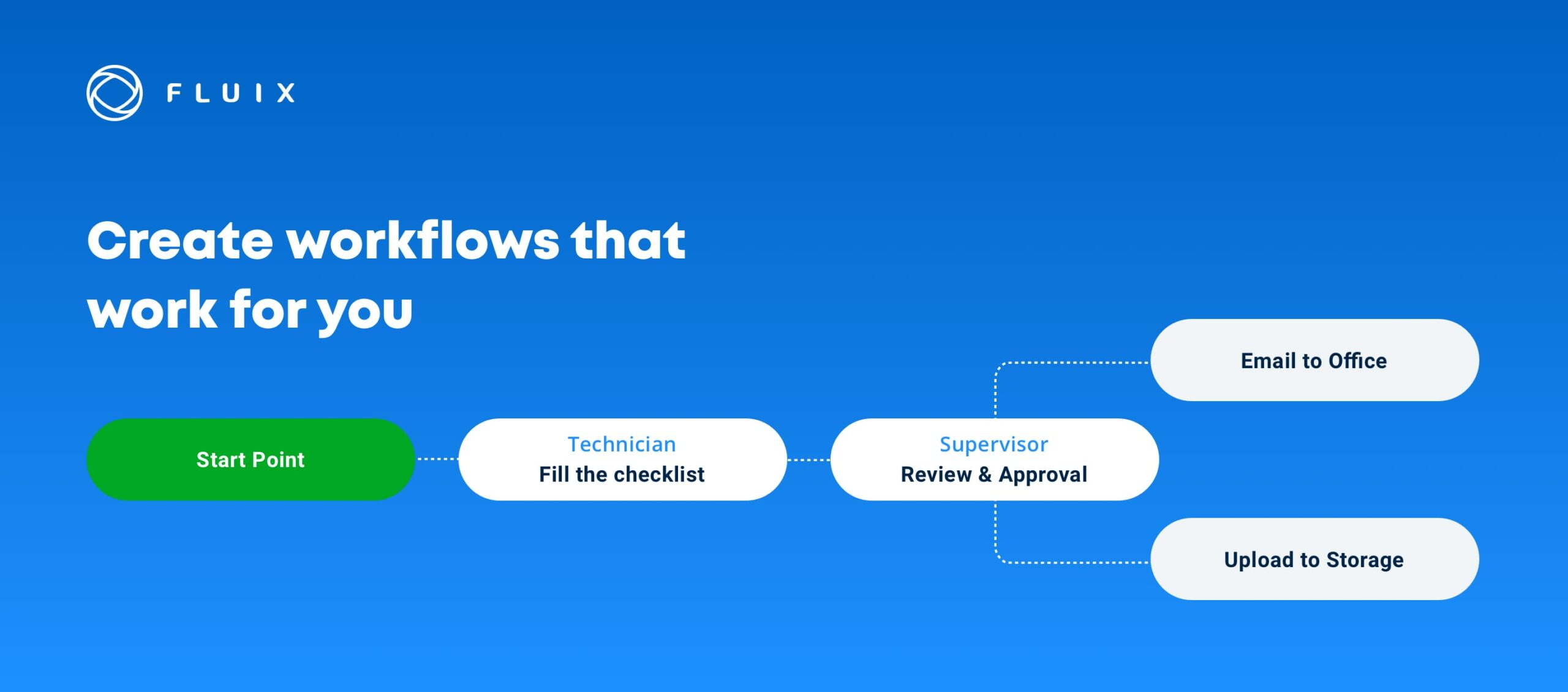Knowing how to create a workflow that drives your bottom line can be the difference between a thriving company and one struggling to stay open. Where does your business fall on this spectrum? Do you have a carefully mapped out workflow plan that directly contributes to your cashflow, or are you just winging it? Do you use a trusted online workflow tool or are you making plans manually?
Established companies with big budgets hire professionals to assist with workflow process development. These professionals complete a full assessment of your business and current operations. They then focus on creating a workflow process that minimizes lags in your operations and improves functionality.
A more cost-effective process involves using workflow automation software such as Fluix to improve your processes. Knowing how to write a workflow plan is essential to going it alone. Learning this skill also ensures you can easily tweak the plan you create as the business changes.
What Is Workflow Management?
Workflow refers to the route everyday tasks follow to take business operations from point A to point Z. For example, at the start of a workday at a factory, two workers may need to complete tasks A and B before another employee can complete C. In the interim, someone else may work on task D but then need the completion of task C to move forward to E.
These interconnections create a workflow process, whether a manager intentionally maps one out or not. Workflow management, development, mapping or planning refers to the process of intentionally creating an efficient and effective workflow. The process involves not just identifying all the necessary tasks but determining what sequence they should occur in.
What Are the Benefits of Workflow Development?
A wise man once said that if you fail to plan, then you plan to fail. While no business owner intentionally encourages failure by not developing a deliberate workflow process, the possibility persists. In some cases, the business may thrive without a deliberate plan. Sometimes, people work well together or do not have tasks that interconnect as often as in other industries.
Even so, not having a deliberate plan hinders growth. Without a workflow map or plan, you don’t have the full picture you need to make informed decisions about improving the business. Should one part of the business suffer a negative impact, you miss out on the necessary tools to better re-organize labor and other resources so you can keep the show on the road.
Knowing how to write workflow process plans also makes it easier to sell or otherwise allow someone else to manage the business. With an established workflow process and documented tasks in place, almost anyone with the right skills can step into your shoes and keep the business rolling. This makes it easier to step away from the company when you’re ready to do so, even if it’s just for a short vacation.
What Are the Steps for Developing a Workflow Plan?
Every project manager and business professional has his or her steps for intentional workflow development. The specific steps depend on the principles followed, individual experience, personal preference and the business’s industry.
Identify Your Business Goals
The best way to determine the need for reconfiguring your work process is evaluating whether the current system meets your needs. Note that even if your current workflow process meets your business goals, you can still improve it and increase efficiency. If your workflow falls short of business goals, then the need to make changes becomes even more urgent.
When looking at business goals, look at both the short-term and long-term goals. For example, if your goal is to reduce employee errors by 20% within the next year, you need monthly or quarterly milestones. Otherwise, it would be difficult to determine how you progress throughout the year. It would also be difficult to determine what progress is good and what level of progress should raise alarm.
Assess Business Performance
When assessing a business for workflow improvement, look beyond the numbers. Collect qualitative data from your employees. For instance, there are many workflow improvement processes that can boost business productivity levels but may cause burnout and high turnover rates among employees. The learning curve for new hires would ultimately eat away at any gains you originally hoped to achieve.
Here are key points to consider when taking a more holistic approach:
- Cashflow generation
- Inventory turnover
- Employee job satisfaction
- Production errors
- Customer retention
Identify Trouble Spots
When assessing the business, it may be tempting to look only at the bigger picture. This could involve your total sales for the quarter or how much inventory you turn over in a month. Dig deeper to discover what your trouble areas are.
The biggest signal of trouble in workflow management is the existence of bottlenecks significantly impeding a process. These, in turn, create additional problems:
- Long wait times for customers seeking assistance or service
- Frequent downtime for some workers
- Lengthy periods spent on non-value-adding tasks
- Frequent errors in one specific section of operations or at a specific time each day
Identify Solutions
Determine what resources you have available to develop efficient workflows. Keep in mind that not all workflow problems require automation to fix them. Sometimes, employees need more or better tools to reduce bottlenecks. When businesses have more time than money, it’s also a good time to get creative with workflow structuring.
The most common and cost-effective workflow solution is to rely on technology like Fluix. In fact, technology can do much of the workflow mapping process for you. Even better, it can automate mundane tasks and free your workers for more creative jobs.
Prioritize the Fixes
When you put your business under a microscope, you might feel amazed by all the things you discover that may be worth fixing. This is only natural. If you truly want what’s best for your business, then nothing is beyond improvement. Even so, you have neither unlimited time nor unlimited finances to fix everything. To remedy this, you need to rank the things you want to fix.
There are many different ways to prioritize fixes. Ultimately, you or the professional you hire may need to come to your own conclusion as to what is best:
- Fix the cheapest problems, so you can generate more cash flow to invest in fixing more things.
- Fix the easiest problems, so you cover more ground in less time.
- Fix the biggest problems, so that you may have the largest impact on workflow efficiency.
- Fix the problems that come most highly recommended by your employees to boost employee engagement and job satisfaction.
- Fix the problems that would resolve the specific problems your customers complain about, so you can reduce customer attrition.
Assign Responsibilities
When making big changes at an organization, it’s easy to lose track of who is responsible for what. If no one is specifically responsible for following up with tasks, then you might lose track of the implementation process altogether. If you hire professionals, they generally become responsible for implementation and follow-up.
Business professionals who choose to implement changes without outside help should consider appointing task leaders in the related areas. For example, consider a construction company that uses workflow management to automate field inspections. The foreman could be responsible for the transition process of training workers, gathering feedback and following up with the general manager.
Visualize the Solutions
Create a diagram to illustrate the workflow processes and how they flow together. It may be beneficial to show the current workflow diagram versus the solutions you wish to create. This can help workers better visualize how to get from point A to point B and why this is important to business operations. Sharing the illustrations can also remind employers that even though they handle individual tasks, their work is part of a larger team effort.
Visual workflows can even help to ease tensions created by bottlenecks and delays in the systems. Workers may feel more understanding when they understand what causes them and how to fix those problems. Finally, understanding the reasons for the changes can help you get better buy-in and cooperation from the employees who must execute these changes in their everyday tasks.
Choose an Appropriate Time
At first glance, the time to fix a problem in the business is always now, but this is rarely the truth. Rushing to implement new policies during peak times might be to the long-term detriment of the business. Implementation is rarely without at least a few hiccups, and even minor changes in a business can lead to long-term inconveniences for customers.
Imagine, for instance, a hotel business in Southern California. During the winter, guests flock to the business, but reservations become fewer and far between in the summer months when desert temperatures can climb to triple digits. Making changes to workflow processes during busy periods could prove disastrous. It would be more appropriate to complete and test changes during the summer downtime.
Implement, Test and Tweak
Business owners often come up with solutions so theoretically perfect that successful implementations seem certain. However, even the most detailed diagram might not take every factor into account. These additional factors can affect how well the proposed solutions work in the real world. This is why testing on a small scale first is so important.
The right mindset while testing is also crucial. Business owners should not approach it with the intention of confirming a theory. Similarly, unsuccessful initial testing is not a failure. With a few tweaks and more testing, managers can bring the situation under control and achieve the final results they had in mind.
Train the Employees
The new generation of workers is more tech-savvy than their predecessors. This often prompts managers to believe their workers will simply figure it out over time. It is better to invest in proper training to ensure employees know how to follow the new workflow process and how to use the technology that makes it possible.
The good news is that while business owners are automating processes, training is one of those tasks it can add to the automation list. For example, Fluix has a training management system that helps businesses move the training process to a completely digital experience. Managers can then document employee progress, issue certificates and schedule follow-ups to answer questions and address concerns.
Why Should I Choose Fluix for Workflow Management?
Fluix provides an all-in-one solution, so you need only one software company to streamline and integrate tasks. This reduces the time employees spend moving between software that serves different purposes, which further boosts productivity and reduces error. This helps you deliver better service to your clients and customers.
So far, our clients have used our software to achieve impressive results, such as 75% less time spent on reporting and saving $300,000 in annual labor cost. Believe it or not, these and other benefits could be yours for as low as $20 per month. Sign up today!






